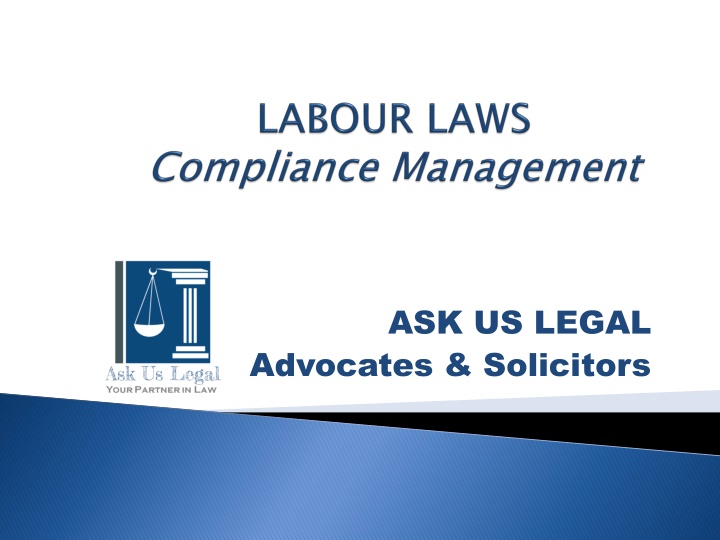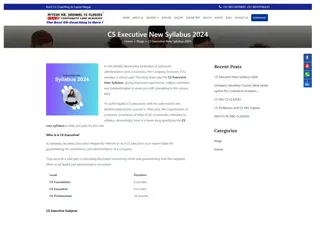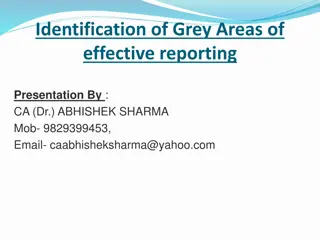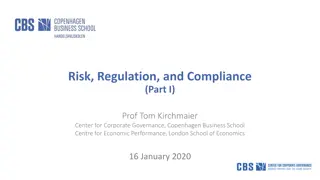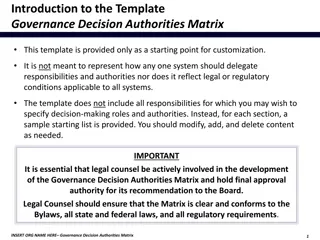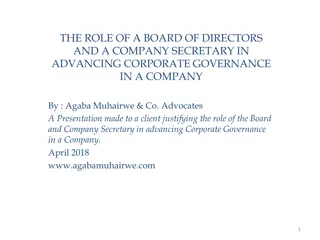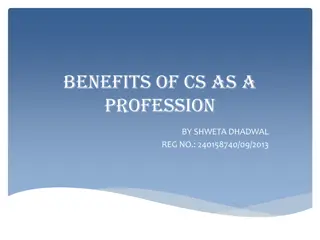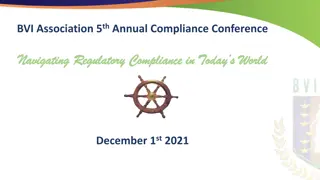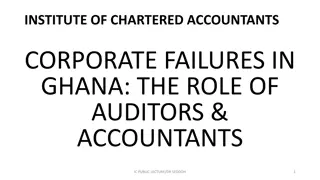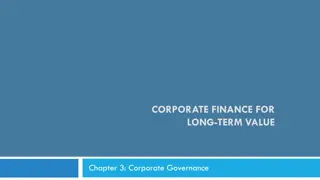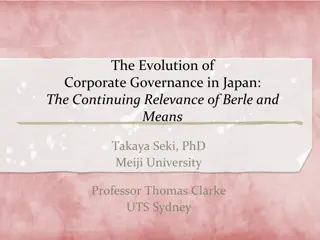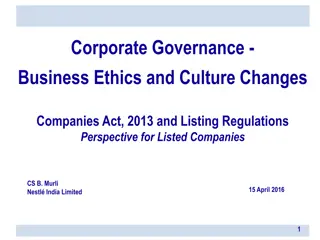Legal Compliance Responsibilities in Corporate Governance
Duties of a Company Secretary, obligations under Listing Agreements, requirements for legal compliance reports, secretarial audit responsibilities, and directors' duty to ensure legal adherence in corporate operations as per relevant laws and regulations.
Download Presentation

Please find below an Image/Link to download the presentation.
The content on the website is provided AS IS for your information and personal use only. It may not be sold, licensed, or shared on other websites without obtaining consent from the author.If you encounter any issues during the download, it is possible that the publisher has removed the file from their server.
You are allowed to download the files provided on this website for personal or commercial use, subject to the condition that they are used lawfully. All files are the property of their respective owners.
The content on the website is provided AS IS for your information and personal use only. It may not be sold, licensed, or shared on other websites without obtaining consent from the author.
E N D
Presentation Transcript
ASK US LEGAL Advocates & Solicitors
LISTING AGREEMENT DUTIES OF COMPANY SECRETARY SECRETARIAL AUDIT DIRECTOR S RESPONSIBILITY STATEMENT
LISTING AGREEMENT Requirement under Clause 49(I)(C)(iii) of the Listing Agreement: The Board shall periodically review compliance reports of all laws applicable to the company, prepared by the company as well as steps taken by the company to rectify instances of non compliances.
DUTIES OF COMPANY SECRETARY Functions of the Company Secretary [Section 205(1)] shall include: (a) to report to the Board about compliance with the provisions of this Act, the rules made there under and other laws applicable to the company; (b) to ensure that the company complies with the applicable secretarial standards; (c) to discharge such other duties as may be prescribed Mandate of Ensuring Legal Compliances by Companies has thus been created vide Companies Act, 2013, by vesting the responsibility of ensuring legal compliance on the Company Secretary .
SECRETARIAL AUDIT Every listed company and company belonging to other class of company shall annex with its boards report, a secretarial audit report given by a company secretary in practice. [Section 204(1)] Other class of companies Every public company having paid- up share capital of 50 crores rupees or more. Every public company having a turnover of 250 crores rupees or more. ICSI s Mandate (Vide its Letter to Members dated December 22, 2014: Examining and reporting whether the adequate systems and processes are in place to monitor and ensure compliance with general laws like labour laws, competition law, environmental laws.
DIRECTORS RESPONSIBILITY STATEMENT Directors had devised proper systems to ensure compliance with the provisions of all applicable laws and that such systems were adequate and operating effectively. [Section 134(5)(f)]
Apprentices Act, 1961, read with Apprentices Rules, 1992 Objective & Framework Creation of trained manpower with skills through theoretical and practical training in number of prescribed trades and occupation. Applicability Apprentices Act, 1961, read with Apprentices Rules, 1992 Objective: Regulation & Control of training of apprentices; Primarily deals with matters like: a) Training & Stipend of Apprentices; their health and safety, working hours, conditions of service, leaves etc. b) Record of trainings c) Maintenance of Registers d) Filing of Records & Returns e) Contract of Apprenticeship Key Compliance & Contentious Issues
Apprentices Act, 1961, read with Apprentices Rules, 1992 Objective & Framework Apprentices Act, 1961, read with Apprentices Rules, 1992 Industrial Establishments where an industry is carried on (Includes all entities in the private sector & public sector) Applicability Key Compliance & Contentious Issues
Apprentices Act, 1961, read with Apprentices Rules, 1992 Objective & Framework (www.apprenticeship.gov.in) has been launched by the Ministry of Skill Development & Entrepreneurship, Govt. Of India (to deal with majority of issues concerning Apprenticeship Training). Apprentices Act, 1961, read with Apprentices Rules, 1992 Dedicated Apprenticeship Training Web-portal Applicability Conditions Apprentices favourable workers/employees. of are as Service at (e.g. leaves discriminatory/less to etc.) of Key Compliance & Contentious Issues times compared regular Apprentices cannot claim right to employment and the status as workmen (Decided by Hon ble Supreme Court in UP State Electricity Board vs Shri Shiv Mohan)
Contract Labour (Regulation and Abolition) Act, 1970, applicable State Rules Objective & Framework certain establishments. Primarily deals with matters like: a) Registration of Establishment by Principal Employer (P.E.), Licensing of Contractors, Liability of Principal Employer (Canteen, rest rooms, drinking water etc. ) & Contractors (Payment of timely & minimum wages, deposit of statutory dues e.g. PF,ESI on time etc.) b) Maintenance of Registers (Muster Roll, Wages Register, Deductions Register etc.) by Contractor, as well as P.E. (Register of Contractors) c) Filing of Annual Returns by P.E.; Half Yearly Returns by Contractor; Filing of Notice of Commencement 7 Completion of Contract work. d) Displays to be made by P.E. Registration Certificate; Abstract of Act (generally in English, Hindi & local language) & Display of Rates of Wages, Hours of Work, Wage Period etc. Contract Labour (Regulation and Abolition) Act, 1970, read with applicable State Rules Objective: Regulate the employment of contract labour in read with Applicability Key Compliance & Contentious Issues
Contract Labour (Regulation and Abolition) Act, 1970, applicable State Rules Objective & Framework Establishment where 20 or more workman are employed on any day of the preceding 12 months as contract labour Contract Labour (Regulation and Abolition) Act, 1970, read with applicable State Rules read with Applicability Contractor who employs or who employed on any day of the preceding 12 months, 20 or more workmen Key Compliance & Contentious Issues
Contract Labour (Regulation and Abolition) Act, 1970, applicable State Rules Objective & Framework Contract Labour should not be engaged for main activities of establishment, but for ancillary activities else same wages/salary and conditions of service need to be provided to Contract labour as is provided to Regular Workmen. Key Compliance & Contentious Issues Contract Labour (Regulation and Abolition) Act, 1970, read with applicable State Rules read with Applicability Statutory Obligations of Contract Labour need to be incorporated in contracts with Contractors, else P.E. is liable for statutory dues e.g. PF,ESI etc. Contractor should engage in purpose as stated in the RC of PE & should provide workers as stated in PE s RC.
Employees' Provident Funds and Miscellaneous Provisions Act, 1952, read with Employees Pension Scheme, 1995 Objective & Framework and deposit-linked insurance fund for employees in factories and other establishments. Applicability Employees' Provident Funds and Miscellaneous Provisions Act, 1952, read with Employees Pension Scheme, 1995 Objective: Regulation of provident fund, pension fund Primarily deals with matters like: Key Compliance & Contentious Issues a) Calculations & deposit of provident fund(PF) within prescribed statutory period; b) Filing of statutory returns (now reduced owing to Monthly ECR) c) PF Transfer, Loan against PF, Pension payments etc.
Employees' Provident Funds and Miscellaneous Provisions Act, 1952, read with Employees Pension Scheme, 1995 Objective & Framework Employees' Provident Funds and Miscellaneous Provisions Act, 1952, read with Employees Pension Scheme, 1995 Every factory/ establishment in which 20 or more persons are employed or as notified by the Central Government, even to an establishment having less than 20 persons. Applicability Key Compliance & Contentious Issues
Employees' Provident Funds and Miscellaneous Provisions Act, 1952, read with Employees Pension Scheme, 1995 Objective & Framework What constitutes as Salary for the purpose of PF Deduction. Salary for PF calculation should not be less than the MinimumWages (to be checked particularly in case Contractors). Option of Voluntary Provident Fund(VPF) to be provided to employees/workers in writing (although Employer not oblized to contribute equal amount) Once a PF Member in any organization, cannot be left out of coverage, merely because he draws remuneration above the prescribed wage/salary ceiling (presently Rs. 15,000/- per month). Principal Employer responsible for default of Contractor, contribution of Contract Labour. Employees' Provident Funds and Miscellaneous Provisions Act, 1952, read with Employees Pension Scheme, 1995 Applicability of Contract Labour deployed through Key Compliance & Contentious Issues w.r.t. statutory payments of PF
Employment Exchange (Compulsory Notification of Vacancies) Act, 1960, read with Employment Exchange (Compulsory Notification of Vacancies) Rules, 1960 Employment Exchange (Compulsory Notification of Vacancies) Act, 1960, read with Employment Exchange (Compulsory Notification of Vacancies) Rules, 1960 Objective & Framework Objective: Compulsory notification of all vacancies in the establishments of private sector (25 or more persons employed) & all establishments of public sector to the employment exchanges, except the following: a) absorption of surplus staff of any branch or department of the same establishment b) held by or on recommendation of any independent agency e.g. UPSC etc. c) domestic service or to do Unskilled Job; Total duration of employment is less than 3 months. Applicability Vacancies proposed to be filled through promotion or Key Compliance & Contentious Issues On the result of any exam/interview conducted or interview Employment in Private Sector(in agriculture); Employment in
Employment Exchange (Compulsory Notification of Vacancies) Act, 1960, read with Employment Exchange (Compulsory Notification of Vacancies) Rules, 1960 Employment Exchange (Compulsory Notification of Vacancies) Act, 1960, read with Employment Exchange (Compulsory Notification of Vacancies) Rules, 1960 Objective & Framework Primarily deals with matters like: Notification of vacancies (15 days in advance of filling up); Notification of selection result (within 15 days of selection) to Employment Exchange. Applicability Submission of Quarterly Return; Biennial Return, Display of Abstract of Act (English & Local language) Key Compliance & Contentious Issues
Employment Exchange (Compulsory Notification of Vacancies) Act, 1960, read with Employment Exchange (Compulsory Notification of Vacancies) Rules, 1960 Objective & Framework Employment Exchange (Compulsory Notification of Vacancies) Act, 1960, read with Employment Exchange (Compulsory Notification of Vacancies) Rules, 1960 All establishments of private sector (wherein 25 or more persons employed) & all establishments of public sector Applicability Key Compliance & Contentious Issues
Employment Exchange (Compulsory Notification of Vacancies) Act, 1960, read with Employment Exchange (Compulsory Notification of Vacancies) Rules, 1960 Objective & Framework Employment Exchange (Compulsory Notification of Vacancies) Act, 1960, read with Employment Exchange (Compulsory Notification of Vacancies) Rules, 1960 Applicability Lack of Awareness of Law amongst corporate entities Key Compliance & Contentious Issues Directorate of Employment (State Government) creating dedicated web-portal for Registration of Establishments; Candidates; Notification of Vacancies etc.
Employees State Insurance Act, 1948 Employees State Insurance Act, 1948 Objective: Compulsory insurance of a specified class of wage earners against certain inevitable risks. Primarily deals with matters like: Objective & Framework Applicability a) Calculations & deposit of ESI contribution (ESI) within prescribed statutory period; b) Filing of statutory returns (now reduced owing to electronic filings) c) Medical benefits, old age medical care, maternity benefit/bonus, unemployment allowances, dependants benefits etc. Key Compliance & Contentious Issues
Employees State Insurance Act, 1948 Employees State Insurance Act, 1948 Objective & Framework Applicable to all factories and establishments other than seasonal factories (in which 10 or more workers are employed) Applicability Key Compliance & Contentious Issues
Employees State Insurance Act, 1948 Employees State Insurance Act, 1948 Objective & Framework Principal Employer responsible for default of Contractor, w.r.t. statutory payments of ESI contribution of Contract Labour. Applicability Establishment to be registered on having 10 employees/workers (irrespective of the fact whether there is not even 1 eligible employee i.e. Drawing salary/wages as prescribed under the Act, for applicability of this Act presently Rs. 15,000/- per month) Key Compliance & Contentious Issues
Payment of Bonus Act, 1965, read with Payment of Bonus Rules, 1965 Payment of Bonus Act, 1965, read with Payment of Bonus Rules, 1965 Objective & Framework Objective: Payment of bonus to persons employed in establishments/factory on the basis of profits or on the basis of production or productivity. Applicability Primarily deals with matters like: a) salary/remuneration of Rs. 21,000/- per month), Computation of gross profits/ availability surplus of the establishment; Payment of Minimum (8.33% of Salary) & Maximum Bonus (20% of Salary); Payment within statutory time limit of 8 months of close of financial year. Eligibility of Bonus (employees/workers drawing Key Compliance & Contentious Issues b) Maintenance of Registers/Records(Form A, Form B, Form C); Filing of Annual Returns(Form D)
Payment of Bonus Act, 1965, read with Payment of Bonus Rules, 1965 Payment of Bonus Act, 1965, read with Payment of Bonus Rules, 1965 Objective & Framework a) Applicable to every factory (as defined under Factories Act) Applicability b) Establishment in which 20 or more persons are employed on any day during an accounting year.(CG may specify lesser no. of employees) Key Compliance & Contentious Issues
Employees State Insurance Act, 1948 Employees State Insurance Act, 1948 Objective & Framework Applicability Violation of statutory provisions (including provisions of payment of bonus, records, returns etc. - particularly by Contractors) Key Compliance & Contentious Issues
Employees Compensation Act, 1923, read with Employees Compensation Rules, 1924 Objective & Framework workmen/employees by their employers for injury which may be suffered by them, as a result of an accident during the course of employment. Primarily deals with matters like: Employees Compensation Act, 1923, read with Employees Compensation Rules, 1924 Objective: Compensation to certain classes of Applicability Key Compliance & Contentious Issues a) Amount compensation, reporting of fatal accidents etc. of compensation, liability of b) Filing of Report of fatal accident etc., Annual Return as to compensation, Display of abstract of Act.
Employees Compensation Act, 1923, read with Employees Compensation Rules, 1924 Objective & Framework Employees Compensation Act, 1923, read with Employees Compensation Rules, 1924 Applicable to factories/establishments, when personal injury is caused to employee (as defined in Act) resulting in total or partial disablement of the employee for a period exceeding three days by accident arising out of and in the course of his employment. Applicability Key Compliance & Contentious Issues
Employees Compensation Act, 1923, read with Employees Compensation Rules, 1924 Objective & Framework Employees Compensation Act, 1923, read with Employees Compensation Rules, 1924 Applicability Non-reporting of matters (particularly w.r.t. Contractual Workmen) Key Compliance & Contentious Issues
Minimum Wages Act, 1948 Minimum Wages Act, 1948 Objective: Fixing minimum rates of wages in certain scheduled employments. Objective & Framework Applicability Primarily deals with matters like: a) Payment of minimum wages, fixing hours of normal work, overtime etc. Key Compliance & Contentious Issues b) Maintenance of Registers & Records, issue of wage slips etc.
Minimum Wages Act, 1948 Minimum Wages Act, 1948 Objective & Framework Applicability Applicable to all scheduled employments (as specified in the schedule and the entries of the state government in the schedule, e.g. factories, commercial establishments etc.) Key Compliance & Contentious Issues
Inter- -State Migrant Workmen (Regulation of Employment and Conditions of Service) Act, 1979 Objective & Framework inter state migrant workman & provide for their conditions of service and matters connected therewith. Primarily deals with matters like: Key Compliance & Contentious Issues Inter State Migrant Workmen (Regulation of Employment and Conditions of Service) Act, 1979 Objective - For regulation of employment of Applicability a) Registration of establishments b) License of Contractors, welfare and other facilities provided to the inter state workmen etc.
Inter- -State Migrant Workmen (Regulation of Employment and Conditions of Service) Act, 1979 Objective & Framework Inter State Migrant Workmen (Regulation of Employment and Conditions of Service) Act, 1979 To employing five or more Inter-State migrant workmen on any day of the preceding twelve months. every establishment/ contractors Applicability Key Compliance & Contentious Issues
Inter- -State Migrant Workmen (Regulation of Employment and Conditions of Service) Act, 1979 Objective & Framework Inter State Migrant Workmen (Regulation of Employment and Conditions of Service) Act, 1979 Applicability Lack of awareness of this law. Key Compliance & Contentious Issues Not very relevant in present day context (good amount of overlapping with Contract Labour Act provisions)
Industrial Employment (Standing Orders) Act, 1946 r/w rules Industrial Employment (Standing Orders) Act, 1946 r/w rules Objective: Defining the conditions of employment by the employers in industrial establishments and make the said conditions known to workmen employed by them Objective & Framework Applicability Primarily deals with matters like: Key Compliance & Contentious Issues Submission of draft Standing Orders to the certifying officer and getting the same approved. Standing orders to cover matters like classification of workmen, hours of work, holidays, leaves, misconduct, suspension/termination rules etc. Display of certified Standing Orders
Industrial Employment (Standing Orders) Act, 1946 r/w rules Industrial Employment (Standing Orders) Act, 1946 r/w rules Objective & Framework Applicability Every 50/100 or more workmen are employed industrial establishment wherein Key Compliance & Contentious Issues
Industrial Employment (Standing Orders) Act, 1946 r/w rules Objective & Framework Industrial Employment (Standing Orders) Act, 1946 r/w rules Applicability Lack of awareness in workmen Key Compliance & Contentious Issues Non display of certified standing orders
Sexual Harassment of Women at Workplace (Prevention, Prohibition and Redressal Objective & Framework sexual harassment in their places of work & to aid them in leading a healthy and safe professional life in the society while protecting their constitutional rights and maintaining their dignity Sexual Harassment of Women at Workplace (Prevention, Prohibition and Redressal) Act, 2013 r/w rules Objective- To protect and prevent women from any ) Act, 2013 r/w rules Applicability Key Compliance & Contentious Issues Primarily deals with matters like: a) Constitution of Internal Complaints Committee (ICC), with majority constitution of women and an external nominee who is familiar with issues of sexual harassment b)Issuance of order of ICC constitution c) Conduct awareness workshops at regular intervals d)Display of penal consequences of sexual harassment
Sexual Harassment of Women at Workplace (Prevention, Prohibition and Redressal Objective & Framework Sexual Harassment of Women at Workplace (Prevention, Prohibition and Redressal) Act, 2013 r/w rules ) Act, 2013 r/w rules Applicability This act is applicable if an employer has employed a women workmen in workplace Key Compliance & Contentious Issues
Sexual Harassment of Women at Workplace (Prevention, Prohibition and Redressal Objective & Framework Sexual Harassment of Women at Workplace (Prevention, Prohibition and Redressal) Act, 2013 r/w rules ) Act, 2013 r/w rules Applicability Lack of awareness and non-seriousness of this law (particularly SME s). Key Compliance & Contentious Issues Representation of management in ICC Lack of competency and understanding of this law in ICC members
Payment of Wages Act, 1936 r/w rules Payment of Wages Act, 1936 r/w rules Objective-To regulate payment of wages of certain classes of employed persons Primarily deals with matters like: Objective & Framework Applicability Display of abstract of acts & rules Key Compliance & Contentious Issues Maintenance of registers, filing of returns etc Payment of wages within 7 days/ 10 days of succeeding month
Payment of Wages Act, 1936 r/w rules Payment of Wages Act, 1936 r/w rules Objective & Framework Applicability Factories, transport services, inland vessels etc Industrial Establishment, Air Key Compliance & Contentious Issues
Equal Remuneration Act, 1976 r/w rules Equal Remuneration Act, 1976 r/w rules Objective: remuneration to men & women workers & for the prevention of discrimination on ground of sex against women in matters of employment and for connected or incidental matters To provide for payment of equal Objective & Framework Applicability Key Compliance & Contentious Issues Primarily deals with matters like: Register maintenance Prohibition of discrimination of recruiting women & Payment of equal remuneration to me & women
Equal Remuneration Act, 1976 r/w rules Equal Remuneration Act, 1976 r/w rules Objective & Framework Applicability Applicable to all establishment and factories Key Compliance & Contentious Issues
Payment of Gratuity Act, 1972 r/w rules Payment of Gratuity Act, 1972 r/w rules Objective: It is a social security measure for employee who have rendered continuous service for five years or more Objective & Framework Applicability Primarily deals with matters like: Key Compliance & Contentious Issues Registration of establishment Payment of Gratuity Display of notice/abstract of act & rules etc
Payment of Gratuity Act, 1972 r/w rules Payment of Gratuity Act, 1972 r/w rules Objective & Framework Applicability Factory, company, education institution, employing 10 or more employees shop, establishment, Key Compliance & Contentious Issues
Factories Act, 1948 r/w rules Factories Act, 1948 r/w rules Objective: Regulation of Factories Objective & Framework Primarily deals with matters like: Applicability a)Safety measures, welfare measures (clean drinking water, rest shelter, canteen, OHS etc.) Key Compliance & Contentious Issues b)working hours, spread over, over time etc.
Factories Act, 1948 r/w rules Factories Act, 1948 r/w rules Objective & Framework Applicability Applicable to all factories wherein 10 or more persons are/were employed with the aid of power or 20 or more workers are/were employed without the aid of power, on any day in the preceding 12 months. Key Compliance & Contentious Issues
Maternity Benefit Act, 1961 r/w rules Maternity Benefit Act, 1961 r/w rules Objective: To provide full and healthy maintenance of woman and her child when she is not working Objective & Framework Applicability Primarily deals with matters like: a) Conditions for claiming benefits, b)Leave for illness arising out of pregnancy etc. c) Grant of maternity leaves, with benefits Key Compliance & Contentious Issues
Maternity Benefit Act, 1961 r/w rules Maternity Benefit Act, 1961 r/w rules Objective & Framework Applicability For all women employees either employed directly or through contractor in factories, other establishments etc. Key Compliance & Contentious Issues
